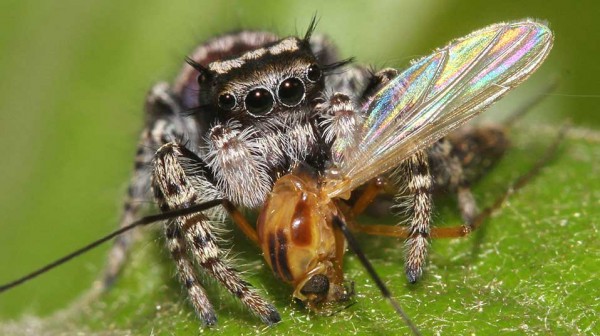By Ana Verayo, | March 18, 2017

Jumping spider Phidippus mystaceus feeding on a nematoceran prey.
Spiders are often seen as terrifying, hair raising creatures. However, a new study suggests that these eight legged insects are apparently a very essential part of our ecosystem, due to the amount of food they consume in a year.
An international team of researchers calculated how much the world's spiders eat, and they came up with 400 to 800 million tons of insects including other animals like bats. On the other hand, humans eat around 400 million tons of meat and fish every year.
Like Us on Facebook
In this new study, Martin Nyffeler of the University of Basel in Switzerland and Klaus Birkhofer of Lund University in Sweden suggest how all the spider species in the world play a crucial role in keeping crop pests at bay. In addition, new findings identify the ecological significance of spiders especially in forests and grasslands.
According to co-author of the study, Martin Nyffeler from the University of Basel, spiders can hunt more efficiently in natural habitats like grasslands as opposed to agricultural fields that has been already disturbed by human activity. Researchers say that more than 90 percent of spider food consist of smaller insects that dwell in the soil that are also closely related to insects.
Spider prey usually consists of flies, mosquitoes, beetles and ants but they can also feast on lizards, fish and even bats and small birds. They also eat other spider species as well.
This voracious appetite is apparently helping your garden flourish. Nyffeler says that spiders can kill large numbers of herbivorous insects, which in turn protect plants from being eaten and further damage. Apart from eating other potential pests, spiders also serve as food to around 3,000 to 5,000 bird species, making them an essential part of the food web.
Researchers were able to calculate the amount of food spiders eat by using published data about average spider biomass for every square meter in several different biome types. They then theoretically applied annual food needs of spiders for every biome. Scientists also utilized data regarding annual prey kill for every meter in spider communities for each biome.
New findings reveals that there is an estimated 45,000 different spider species on Earth and this results in an estimated food weight of 25 million tons. Nyffeler says, we hope that these estimates can highlight their significant magnitude to raise more awareness and increase the level of appreciation of spiders. Most importantly, highlight the global role of spiders as a crucial part in terrestrial food webs.
This new study is published in the journal The Science of Nature.
-
Use of Coronavirus Pandemic Drones Raises Privacy Concerns: Drones Spread Fear, Local Officials Say

-
Coronavirus Hampers The Delivery Of Lockheed Martin F-35 Stealth Fighters For 2020

-
Instagram Speeds Up Plans to Add Account Memorialization Feature Due to COVID-19 Deaths

-
NASA: Perseverance Plans to Bring 'Mars Rock' to Earth in 2031

-
600 Dead And 3,000 In The Hospital as Iranians Believed Drinking High-Concentrations of Alcohol Can Cure The Coronavirus

-
600 Dead And 3,000 In The Hospital as Iranians Believed Drinking High-Concentrations of Alcohol Can Cure The Coronavirus

-
COVID-19: Doctors, Nurses Use Virtual Reality to Learn New Skills in Treating Coronavirus Patients







